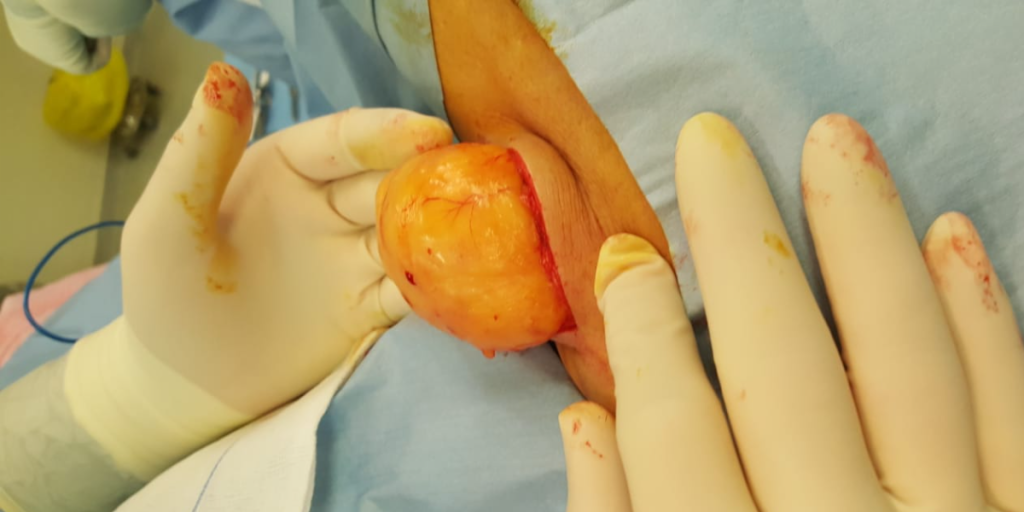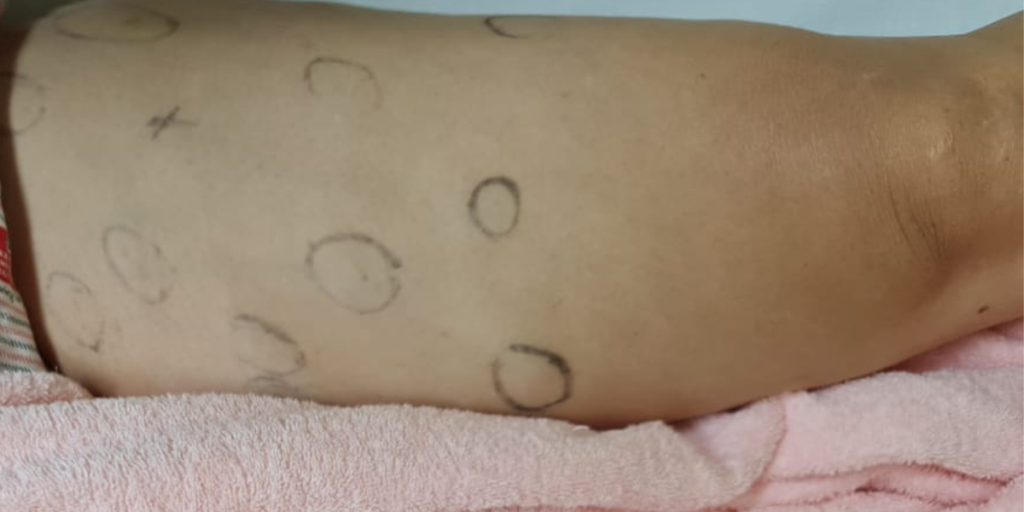You’re taking your daily shower and notice a slight bump while scrubbing your back. You think it’s probably just a pimple or a bug bite.
Weeks pass, and it doesn’t subside. Weeks turn into months, and you begin to ignore its existence.
A few years have passed, and one day, you notice a slight discomfort while sleeping. That small bump had grown large enough that even lying down became uncomfortable.
Is it cancer? Should I have popped it like a pimple years ago?
In this article, we explore the ins and outs of lipomas.
What is lipoma?
A lipoma is a non-cancerous tumour made up of fat cells. In other words, it is essentially a lump of fat that grows abnormally. A capsule usually surrounds the lipoma.
It usually develops under our skin in the layer called the subcutaneous tissue.
*Below it’s how lipoma looks like, scroll away if is too much for you.

Are lipomas cancerous?
No. Lipomas are benign tumours. It means that they are abnormal growths but are not cancerous.
The rare cancerous counterpart of lipomas is called liposarcoma. While it is technically possible for a lipoma to transform into a liposarcoma, it is rare.
If you have a concerning lump, it is crucial to get it evaluated by a doctor. But first, ensure that you are not dealing with other potentially dangerous bumps.
Symptoms of lipomas
Patients would notice a lipoma as a lump on their body.
While a lipoma can develop at any part of the body, it occurs most commonly on the:
- Trunk
- Shoulders
- Neck
- Arms.
The lump would be soft and painless. However, irritation with pressure and friction may cause some pain and discomfort. Lipomas vary in size and shape.
Lipomas are also mobile. They can be moved around easily under the skin.
Lipomas grow at a slow rate. Therefore, many patients would only notice the lipoma years down the line.
How common are lipomas?
Lipomas are one of the most common tumours in humans.
While there is a lack of data on how common it may be, we may estimate that it affects up to 1% of the population. They can occur at any age but develop more commonly in the 40–60-year-old range.
Lipomas are also slightly more common in males compared to females.

Are lipomas dangerous?
Most lipomas are harmless. However, there are some caveats. While these lipomas are slow-growing, they can grow large enough over time to cause issues.
For example, a lipoma at one’s eyelid may grow large enough to affect one’s vision.
A giant lipoma can also compress the surrounding structures, such as blood vessels and nerves. It then leads to further complications.
While lipomas usually occur under the skin, they can also grow anywhere in our bodies. If they form in our muscles or organs, they may interfere with the functions of the affected organ or muscle.
Lastly, when a patient develops multiple lipomas, it may be due to a genetic condition, especially if they have family members with similar complaints.
How do lipomas develop?
The exact cause and mechanism of how lipomas develop are unclear.
Genetics may play a role in the development of lipomas. It is because many affected patients have a family history of lipomas.
Injuries may also potentially trigger the growth of a lipoma. Many patients in the past experienced this phenomenon.
MYTHS
Do herbal remedies work in treating lipomas?
Many unproven claims of herbs and creams promise to treat lipomas. Some products are also readily available to be purchased online. However, there are NO topical treatments that are proven to treat lipomas.
One should be wary of these products. They may contain chemicals and substances that may do more harm than good.
Lipomas are always small. Many believe that lipomas are small and will remain small. Lipomas remain small for long periods due to their slow growth.

However, the most giant documented lipoma weighed 22.7kg. Then, the surgeon removed it in 1894.
We can’t remove a small lipoma ourselves at home. As a lipoma is a clump of fat, it is unlike a pimple. Therefore, popping it will not help to remove it.
Attempting to remove it using a pin or blade would probably cause more harm than good. It is because you are likely to cause excessive harm to the area.
Furthermore, you may potentially be introducing an infection to the site.
How are lipomas diagnosed?
The diagnosis of a lipoma is usually a clinical one. It means that no special tests are required. Instead, a doctor typically relies on questioning and a physical examination to diagnose the lipoma.
If there are any doubts, the doctor may perform an ultrasound scan. It enables the doctor to better look at the structures under the skin.
Sometimes, the diagnosis can still be unclear, or there may be some suspicious features. In such cases, the doctor may opt for a lump biopsy.

A sample is taken and sent to the lab for examination.
Based on the case-to-case basis, there might be other tests involved as well.
How are lipomas treated?
As lipomas are generally harmless, treatment is usually not required. However, they may require long-term follow-up for observation. However, there are some exceptions.
The most common reason for the treatment of lipomas is cosmetic reasons. As a lipoma may grow larger over time, it may become aesthetically unpleasing. It may also affect a patient’s self-confidence and become psychologically distressing.
Depending on the location of the lipoma, it may interfere with a patient’s quality of life. For example, a lipoma on the sole of the foot causes discomfort when the patient is walking.
With long-term observation, suspicious changes may also warrant treatment. It is such as rapid growth of the lump or development of pain.
If treatment is required, the usual approach is the removal of the lipoma via surgery. It is done with a simple incision in the skin to extract the lipoma. The fat with its capsule is removed in the procedure.
Liposuction might be a way to remove a lipoma. The surgeon will use a tube to suck out the fat. Usually, it’s for large lipomas. However, it is difficult to remove a lipoma using liposuction completely.

For a small lipoma, steroid injections are also an option. However, the steroid causes fat to break down along with the injection. As a result, it causes shrinking of the lipoma but does not entirely remove it.
Over the years, surgeons are still testing other injection therapies. As a result, some centres may offer these experimental therapies. However, patients need to know that the effectiveness of such treatments is still in research.
Should I expect the lipoma to reoccur?
In most cases, lipomas do not reoccur after surgical removal.
Recurrences may occur if the lipoma is not removed thoroughly during the surgery. The risk of recurrence is higher if a surgeon uses liposuction and steroid injections.
Weight loss and lipomas
In many patients, lipomas tend to increase in size with significant weight gain. On the other hand, they do not significantly shrink with weight loss.

In theory, this is because of the different origins of a lipoma’s fat cells and the fat we usually find under our skin.
Diet and other lifestyle changes seem to have little effect on the growth and shrinkage of lipomas.
Can I prevent a lipoma?
To date, the exact cause of lipoma development is still unclear. Currently, there is no proven way to prevent the growth of lipoma.
Nevertheless, we encourage everyone to be health-conscious and lead a healthy lifestyle. If you seek advice on how to do so, feel free to consult a healthcare provider.
Differential Diagnoses of a lipoma?
Most lipomas diagnose without special tests. Therefore, some other lesions may mimic a lipoma. The doctor will exclude these during an evaluation.
Cysts
It is a common fluid-filled lump. The bump commonly has a small opening called a punctum. It sets it apart from a lipoma.
Abscess
Abscesses are pus-filled bumps caused by infections. They develop in a short period.
Abscesses are different from a lipoma with the presence of inflammation. They are painful, red and swollen.
Angiolipoma
It is a tumour composed of fat and blood vessels. It is usually difficult to distinguish it from a lipoma. However, pain is more commonly present with angiolipomas.
Liposarcoma
It is the cancerous counterpart of lipomas. They generally form much deeper compared to a lipoma. Therefore, patients would develop other complications and symptoms before noticing a lump.
As mentioned before, multiple lipomas may be a feature of a genetic disease. Upon suspicion, the professionals will explore further. Familial multiple lipomatosis, Gardner syndrome and Cowden syndrome are some diseases, to name a few.
Conclusion
Lipomas are a common cause of skin lumps. They are generally harmless but may require treatment if deemed necessary.
If you notice a lump on your body, we encourage you to consult a healthcare professional for an evaluation.
References:
- https://www.ncbi.nlm.nih.gov/books/NBK507906/
- https://dermnetnz.org/topics/lipoma-and-liposarcoma
- https://www.aafp.org/pubs/afp/issues/2002/0301/p901.html
- https://bestpractice.bmj.com/topics/en-us/981
- https://www.aafp.org/pubs/afp/issues/2002/0301/p905.html
- https://www.ncbi.nlm.nih.gov/books/NBK482343/